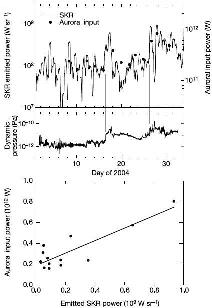In this article published in Nature, the radio observations were carried out by the RPWS (Radio and Plasma Wave Science) experiment onboard Cassini, and the UV observations by the STIS camera of the Hubble Space Telescope, during a joint campaign in January 2004, 5 months before Cassini entered in orbit around Saturn.

The team of astronomers showed that the variations of UV and radio aurorae are well correlated to each other and to the fluctuations (of pressure, in particular) of the solar wind at Saturn level (cf Figure 2). In particular the southern auroral radiosource was identified with a bright UV arc (noted "A" on Figure 3).

However, contrary to the aurorae on Earth, the Saturn aurorae are not strictly fixed in local time, but simply restricted inside an interval of a few hours of Local Time, inside which they are in partial corotation with the planet. The radio emission (at the local electronic cyclotron frequency), very anisotropic, is maximum at 55-70° of the magnetic field in the source (which explains the difficulty to find out UV-Radio correlations on a small temporal scale). These figures are close to the values on Earth and Jupiter, and confirm the assumption (supported by other arguments) of a common microscopic generation mechanism.

To obtain the correlations presented here, a "polarization filtering" of the data was developed at LESIA (where was designed and built the receiver HFR, principal subset of RPWS). This filtering allows to isolate the auroral radio emission of Saturn from the other emissions which are superimposed to it (cf Figure 4).

Finally let us note that several "magneto-plasma enigmas" still exist at Saturn, that Cassini should gradually unveil. Two important issues are : the strong modulation of Saturn’s auroral radio emission by planetary rotation (contrary to its terrestrial counterpart) although the sources are limited to a local time sector and although the magnetic field measured by the probes Pioneer and Voyager is perfectly axisymmetric. The explanation of this paradox is probably related to a localised magnetic anomaly close to the surface... (see Galopeau et al.. 1991, JGR 96, 14129 and Galopeau & Zarka 1992, JGR 97, 12291) ; the radio period of Saturn (considered, as for all giant planets, as true sideral rotation period of the planet) fluctuates by 1% on a few months scale ! This enigma raised by Galopeau & Lecacheux (2000, JGR 105, 13089) is about to be solved ...
Reference
- An Earth-like correspondence between Saturn’s auroral features and radio emission W. S. Kurth(1), D. A. Gurnett(1), J. T. Clarke(2), P. Zarka(3), M. D. Desch(4), M. L. Kaiser(4), B. Cecconi(1), A. Lecacheux(3), W. M. Farrell(4), P. Galopeau(5), J.-C. Gerard(6), D. Grodent(6), R. Prangé(3), M. K. Dougherty(7) & F. J. Crary(8) Nature, published 17 February, 2005 (1) The University of Iowa, USA — (2) Boston University, USA — (3) Observatoire de Paris, France — (4) NASA/Goddard Space Flight Center, Greenbelt, USA — (5) CETP/UVSQ, Velizy, France — (6) Université de Liège, Belgium — (7) Blackett Laboratory, London, UK — (8) San Antonio, Texas, USA
Contact
- Philippe Zarka
(Observatoire de Paris, LESIA)
